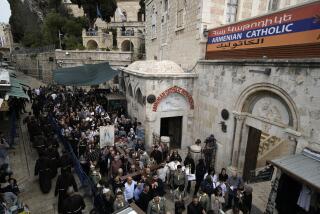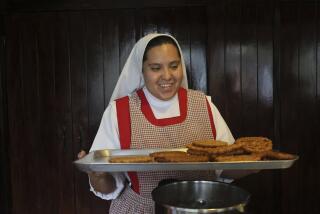Hunger for tradition at fish fry
LITTLETON, COLO. — The line starts forming when the doors open at 5 p.m. and it doesn’t let up, snaking around the hall at St. Frances Cabrini Parish. Men in blue vests -- members of Knights of Columbus Archbishop Casey Council 9349 -- ask people whether their sacrifice will be of the fried or baked variety.
Kids with skateboards and men with canes share tables. Warnings that “fish have bones” are plastered all over the walls. There are jokes, speeches -- and one complaint that the lemonade is too weak.
Scenes like this one in a Denver suburb play out each Friday during Lent under the fluorescent glow of a thousand Catholic parish halls.
The old-fashioned Lenten fish fry soldiers on, giving Catholics an opportunity to observe their meatless Friday while bolstering their sense of community.
To a number of Catholics, the fish fry is also something more: a timeworn Catholic tradition that provides a safe haven from divides that have long roiled the U.S. church, a place where traditionalist Catholics, progressive Catholics and everyone in between can sit peacefully at the same plastic tablecloth.
“Looking out, I see people from very different, various views of the church sitting down at the table and sharing a meal together, just as we do in the church,” said the Rev. Sean McGrath, the parish priest at St. Frances Cabrini, as he worked the crowd on a recent Friday. “Feed their bellies, feed their souls.”
Although Catholics have a long history of living out their faith through practice, many traditions shrank into the background after the modernizing Second Vatican Council of the 1960s.
The council emphasized communal worship and the Scripture, and casualties included private devotions, symbols and some strict rules.
Among the practices that fell in stature were fasting, saying the rosary and Eucharistic adoration, in which the faithful sit in quiet prayer before the sacramental bread Catholics believe is the body of Christ.
Now many of those practices are getting a fresh look -- and not just from traditionalist Catholics who miss the old ways of doing things, but from Catholics across the spectrum who recognize their value, too.
“There are people who are wondering whether or not some important things have sort of slipped away and could be brought forth,” said James Davidson, a Purdue University sociologist and expert in American Catholic observance. “Not just because they are old, traditional and sort of conservative. But because they at some point mattered to people and could be a sources of strengthening Catholic identity in today’s world.”
Case in point: This spring, Boston College’s Church in the 21st Century Center published a guide to Catholic spiritual practices ancient and new. One essay was about lay Catholics finding a rhythm in their busy lives by praying the Liturgy of the Hours, a time-consuming regular routine for priests and deacons. Other contributions covered the rosary, labyrinth walking, retreats, petitioning saints and prayer podcasts.
The response was dramatic, with orders pouring in from parishes, retreat houses and a chaplain at a women’s prison who wanted 500 copies, said John McGinty, the center’s acting director.
“The pathways by which we do Catholicism may have become less clear to a number of us, maybe a lot of us over recent years,” McGinty said. “The rediscovery that there are both well-worn and newer paths that really can both express and strengthen what you believe . . . that seems to be in the air now.”
Practices such as Eucharistic adoration, devotion to saints or making a pilgrimage to a holy site are usually viewed as conservative or traditionalist Catholic territory.
While there is some truth to that, it need not apply to many practices that saw their heyday before Vatican II, said Michael Daley, a teacher at St. Xavier High School in Cincinnati.
“Traditional or conservative Catholics would say, ‘We do that, liberal Catholics don’t do that,’ ” said Daley, who is co-editing a forthcoming book that includes contributions from several Catholic thinkers on the left promoting refurbished traditional Catholic practices. “We would say, ‘All Catholics do that, because it’s a wonderful practice and it’s served Catholic Christians for hundreds of years.’ ”
In the Archdiocese of Chicago, parishes turn to a grab bag of practices to connect with busy young adults during Lent, said Kate DeVries, associate director of young adult ministry.
Last year, instead of urging people to give up chocolate or some other indulgence for the 40-day period, the archdiocese posted an idea online each day. Examples: Call a friend. Say a decade of the rosary. Spend 10 minutes in prayer.
Parishes stage “soup and Scripture” events, vespers services -- and fish fries.
At Saint Frances Cabrini, the fish fry draws about 500 people per week. The event’s popularity also has boosted attendance at a stations of the cross service that follows. Another traditional Catholic practice, the service is built around solemn reflections on Jesus’ last steps before his crucifixion and death.
The parish’s fish fry has supplanted bingo as a fundraiser. On this night, proceeds go to support local seminarians.
The menu is a long ways from Mrs. Paul’s Fish Sticks or salmon loaf. The choices are fried pollock or baked mahi-mahi with fries or rice. The healthier option was added to reflect the changing times.
“You come, you sit, you mingle and meet people you otherwise wouldn’t meet,” said Ray Drubula, a retired railroad worker who oversees the operation. “It’s a community-builder.”
Before Vatican II, Catholics were required to abstain from eating meat every Friday -- a sacrifice honoring the day Jesus Christ died -- and fast on all weekdays in Lent. Now, Catholics are expected to avoid meat only on Ash Wednesday and Fridays during Lent, and fast on Ash Wednesday and Good Friday.
Some emphasis shifted to voluntary expressions of penance and fasting, as well as forms of self-denial other than avoiding meat.
For some Catholics, giving up Facebook or their iPhone for Lent is a much greater sacrifice than giving up prime rib each Friday, especially since many people limit meat intake as it is.
Abstaining from meat on Fridays in Lent “is more of a choice now,” said Paul Grimm, a deacon at Saint Frances Cabrini. “It was an absolute -- ‘You’re going to do this or you’ll fry in hell.’ Now it’s very grass-roots. It’s not so much a sacrifice as it is a reminder of who we are. And what Christ is.”
A few tables away, 31-year-old Amanda Hupka said the fish fry and other practices like her participation in a “rosaries for life” circle with other women on Wednesday nights help nourish and challenge her.
“The church can give you ways to teach you self-control, obedience and sacrifice for others,” said Hupka, a mother of four and part-time school librarian.
“Things like this, learning what sacrifice really means, is significant. It gives people a taste of what the faith is truly about instead of a watered-down version.”
More to Read
Sign up for Essential California
The most important California stories and recommendations in your inbox every morning.
You may occasionally receive promotional content from the Los Angeles Times.










